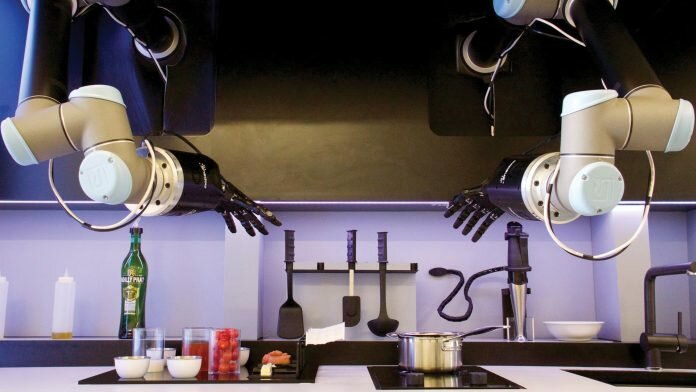
Reinhard Lafrenz, secretary general of euRobotics, explores how robots can be deployed in retail and hospitality sectors with support from the EU on RD&I.
Turn up at the Henn-Na Hotel in Japan and multi-lingual robots will help you to check in, a robotic arm will store your luggage, and you will be able to use a face-recognition system rather than a room key. The Henn-Na, which claims to be the world’s first hotel staffed by robots, might point to a brave new world of friendly robots helping us in our daily lives. But many technical and societal challenges must be overcome before the public can expect to interact with a friendly, helpful robot whenever they enter a shop, hotel, museum, or other semi-public space.
However, robots have been used increasingly in the retail sector to improve handling and distribution in supply chains. For example, the UK online supermarket Ocado is developing a warehouse with thousands of robots that will work together to retrieve groceries from storage to assemble customers’ orders. Ocado has also been evaluating robot picking and packing to reduce costs and improve efficiencies, as well as testing an electric, self-driving delivery vehicle in London.
Ocado is a member of euRobotics, an association that represents many of Europe’s robotics actors, including robot and component manufacturers from:
- Very small to global players;
- Universities;
- Research organisations; and
- End users.
euRobotics represents the private side of the SPARC public-private partnership on robotics with the European Commission.
The early days of robotics
A lot of innovation is still needed before robots can become common for retail and hospitality uses which involve close contact with the public. Tony Cohn, professor of automated reasoning at the University of Leeds, UK, a member of euRobotics, says that avoiding human-robot interaction would be simpler, as with factory robots fenced off safely and performing standard, repetitive actions, but adds: “That’s still pretty tricky.”
Cohn says that it may be relatively easy to get a robot to recognise and pick up an isolated object on a table, for example, by considering all possible trajectories to determine the best one. But in a cluttered environment, such as the back of a fridge, a robot would probably struggle to pick up the object without touching anything else. “It’s not possible to get a yogurt out of the fridge before you die of hunger,” says Cohn.
Robotics researchers at Leeds plan to use virtual reality to understand how humans manipulate objects in cluttered spaces, perhaps pushing things aside. They will then apply machine learning to extract rules for robots, bypassing the usual approach of using low-level probabilistic methods often based on random sampling. Despite the difficulties, Cohn sees the potential for retail robots close to humans, such as helping at check-outs in shops: “I can certainly see applications like that. It would not be too difficult.”
The Henn-Na robots are an example of the limited human-robot interaction that is already possible. However, deploying robots which allow humans to imagine that they are interacting with other humans is not possible, says Valeria Villani, an assistant professor in the Department of Sciences and Methods for Engineering at the University of Modena and Reggio Emilia in Italy. She sees such interaction as a “hot area of research” and thinks that we will eventually have robots that we can think of as fellow humans.
Dr. Agnieszka Wykowska, a senior researcher at the Italian Institute of Technology (IIT), an euRobotics member in Genoa in Italy, says that it is early days for human-robot interaction, such as for the retail and hospitality sectors. “There is so much to be done. We don’t know anything at the moment,” she says. “The more interaction with humans, the more difficult it is. The most challenging environment is probably the home where it is unstructured.”
Room for improvement
There is a need for better technologies for robots, such as sensors and actuators which are able to detect and express emotional states, according to Professor Andrea Bonarini, in the artificial intelligence and robotics laboratory of the Department of Electronics, Information, and Bioengineering at the Polytechnic of Milan in Italy, another euRobotics member. Robots might need to understand the expressions on the faces of people and then react appropriately. “That’s very much at the beginning, in terms of integration into robots,” says Wykowska. A better understanding of how humans react to robots is also needed, she adds.
What will a robot understand if a human points at something, for example? If a robot points its arm, how will a human interpret the gesture? For example, a person is likely to look where another human is pointing, establishing a joint focus of attention which is known as being socially attuned. However, if a robot’s artificial arm is pointing, the person might ignore the gesture because they do not believe that it has an intentional content and that the robot wants to show them something; the person might see the arm as just a randomly-moving thing.
Therefore, humans may not be ready to attune socially with humanoid robots until robots imitate human-like behaviour with subtle and often implicit social signals, such as gaze, head and hand movements, body posture and sounds, according to Dr Alessandra Sciutti, at IIT. The cognitive research needed to answer such puzzles has only recently attracted much interest from experimental psychologists, adds Wykowska. However, a psychology conference last December showed the growing activity: “I saw so much more interest than, say, five years ago.”
That is reflected in the targeting of grants for robotics research and innovation, she says: “The human aspect is becoming more important for robotics, as it is becoming more important generally.”
The likely benefits
Solving the puzzles associated with human-robot interaction could be good for retail and hospitality robot buyers and for their customers, the public. “The main benefits of robots are reduced operation costs and optimised processes,” says Andreas Bley, the managing director of MetraLabs, a German company that makes mobile service robots. “Robots seem to be a major investment at first sight. So there is a need to explain in detail that the long-term savings from robots outweigh the high initial costs within a relatively short period.
“Depending on the sector, there are more specialised benefits, e.g. more frequent and accurate inventory in retail, improved customer service in shops or museums.” The latter could include a marketing or public relations function, he adds: “They also wish to have robots to attract their customers’ attention and to present themselves as modern, customer-oriented companies.” Ruan Jones, a technology expert at PA Consulting, says: “Hospitality robots will (as for the industrial versions) have to provide the necessary performance but they will also need to engage on an emotional level.”
Both Villani and Professor Raffaella Carloni, in the Faculty of Science and Engineering at the University of Groningen, the Netherlands, think that robots exhibiting human-like characteristics could be used in retail, hospitality and other sectors in five to 10 years’ time, initially in somewhere such as Japan.
Widespread concerns
Yet many factors could slow the advance of robots, on top of the technical difficulties, such as:
- Making robots safe;
- Making them understand humans; and
- Making them easy for non-technical retail and hospitality staff to use.
Safety risks associated with collaborative working should be high on the agenda,” says Jones. “Risks of injury rise as the load being moved, or the speed of movement, increases, as this affects the momentum of any impact. This imposes significant implementation constraints unless effective sensing can be guaranteed.” However, he expects advances in sensing and AI to result in fail-safe systems for robots working in open and accessible environments. He also expects that hardware and software design will provide security against malicious interactions, with the overall system design having to consider the additional associated risks.
“There are ethical issues to take into account,” says Carloni. Rich Walker, managing director of the robotics hand company Shadow Robot, based in the UK, says that the ethical response will depend of whether robots are good at their tasks and visible. “A robot ‘maître d” might be a great thing,” he says. “Robot dishwashers and laundry cleaners definitely displace people and might be seen as a bad thing.”
There are also legal and socio-economic concerns. “There is clearly a need for guidelines,” says Cohn. “It’s early days but these are important issues.” Future public opposition to, or fear of, robots is difficult to forecast. “It is possible that the public opposition will limit the market’s potential,” says MetraLabs’ Bley. “But it is not our goal to replace employees, but to support them in their daily working routine. Our robots are supposed to relieve employees from time-consuming and resource-intensive tasks. We strive for a future where humans and robots work hand in hand.”
Shadow has supplied robotic hands for a robotic chef developed by Moley Robotics; perfect crab bisque every time, says Walker. Although he thinks that retail and hospitality robots will initially be marketing gimmicks: “Things like laundry service or room service could show a return fast.”
He expects the big firms to become important as systems reach the market: “White goods manufacturers will be the real players in this area. Expect start-ups to rapidly get bought by major players.”
Some observers have forecast public fear of humanoid robots that appear around every corner, but Cohn says that most people reacted positively to the robots which he tested at care homes, even though a few people hated the robots enough to try to sabotage them. Walker sees the inability of robots to offer good-enough functions as more of a break on market development than public opposition or fear.
More support needed
The future of retail and hospitality robots will partly depend on funding by the European Commission’s research and innovation initiative Framework Programme 9, which will follow the current Horizon 2020 initiative which runs until 2020.
euRobotics has helped to direct Horizon 2020 funding for robotics – €700 million of EC project funding in 2014 – 2020 to be combined with €2.1 billion of private money – and has supported the Commission’s plan to develop robotics Digital Innovation Hubs around the EU’s regions. With euRobotics’ support, the European Commission is focusing on four ‘lighthouse’ application areas:
- Agri-food;
- Healthcare;
- Inspection and maintenance of infrastructure; and
- Agile production.
However, the use of retail, hospitality, and other robots, could be boosted with national and local initiatives around Europe. Walker, an euRobotics board member, says that there is a need for test areas where robots can be deployed and perhaps tax breaks for deploying them.
Robotics is already seen by policymakers as important for the EU in terms of innovation, jobs and the economy, even if attracting research funding is difficult, says Carloni: “I think that robotics is quite a lot in the spotlight, from the point of view of policymakers in Europe.” The Henn-Na Hotel could show European policymakers the potential if they wished to check in and check it out.
euRobotics
euRobotics is a Brussels-based international non-profit association that works to boost European robotics research, development and innovation, and to foster a positive perception of robotics. The 250-plus members range from research organisations and universities to companies, including manufacturers, as well as providers and users of robotics systems and services.
euRobotics aims to strengthen competitiveness and collaboration to ensure that robotics is adopted widely for professional and private use. It helped to developed the strategy and roadmap for robotics in the Horizon 2020 research and innovation programme of the European Commission. In September 2012, euRobotics and the EC set up SPARC, a public-private partnership to support robotics, with €700 million of EC project funding in 2014 – 2020. The private side is expected to invest another €2.1 billion. SPARC aims to help researchers and companies to form alliances and to focus on work that will yield successes that will benefit all concerned.
A new initiative is the EC call for European networks of robotics Digital Innovation Hubs to stimulate innovation and knowledge transfer in local environments, with the regional hubs linked at the European level.
Reinhard Lafrenz
Secretary General
euRobotics
https://www.eu-robotics.net


















